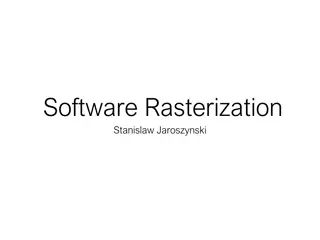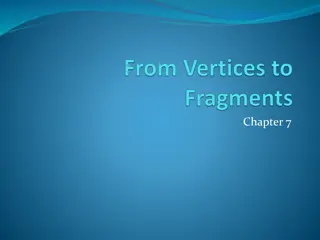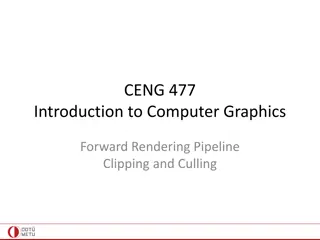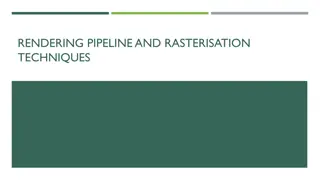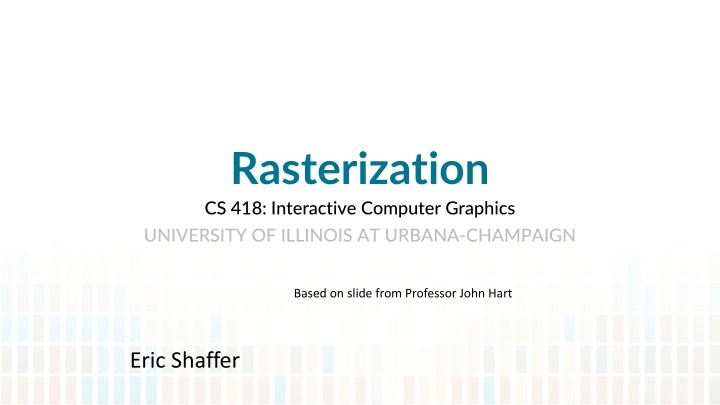
Rasterization in Interactive Computer Graphics at University of Illinois
Explore the process of rasterization in interactive computer graphics at University of Illinois, based on slides from professors John Hart and Eric Shaffer. Learn about converting geometric primitives to pixels, drawing lines using algorithms like Bresenham's, and the Midpoint Algorithm for plotting pixels. Dive into concepts like choosing pixels to illuminate, simplifying line drawing problems, and computing fast for efficient graphics rendering.
Download Presentation

Please find below an Image/Link to download the presentation.
The content on the website is provided AS IS for your information and personal use only. It may not be sold, licensed, or shared on other websites without obtaining consent from the author. If you encounter any issues during the download, it is possible that the publisher has removed the file from their server.
You are allowed to download the files provided on this website for personal or commercial use, subject to the condition that they are used lawfully. All files are the property of their respective owners.
The content on the website is provided AS IS for your information and personal use only. It may not be sold, licensed, or shared on other websites without obtaining consent from the author.
E N D
Presentation Transcript
Rasterization CS 418: Interactive Computer Graphics UNIVERSITY OF ILLINOIS AT URBANA-CHAMPAIGN Based on slide from Professor John Hart Eric Shaffer
Fragment Pipeline Rasterization is the process of converting vector graphics-style geometric primitives into a set of pixels
How to Draw a Line Jack Bresenham s Algorithm Given a line from point (x0,y0) to (x1,y1) (x0-x1, y0-y1) (x1-x0, y1-y0) (x0,y0) (x1,y1) How do we know which pixels to illuminate to draw the line? First simplify the problem to the first octant Translate start vertex to origin Reflect end vertex into first octant
x = y y = -x x = y y = x x = -x y = y x = x y = y x = x y = -y x = -x y = -y x = -y y = x x = -y y = -x
Line Rasterization How to rasterize a line from (0,0) to (4,3) Pixel (0,0) and (4,3) easy 4 One pixel for each integer x-coordinate 3 Pixel s y-coordinate closest to line ? 2 If line equal distance between two pixels, pick one arbitrarily but consistently ? 1 0 0 1 2 3 4
Midpoint Algorithm Which pixel should be plotted next? East? Northeast? NE E
Midpoint Algorithm Which pixel should be plotted next? East? Northeast? Line equation y = mx + b f < 0 NE m = (y1 y0)/(x1 x0) f >0 M b = y0 mx0 E f(x,y) = mx + b y
Midpoint Algorithm Which pixel should be plotted next? East? Northeast? Line equation y = mx + b m = (y1 y0)/(x1 x0) b = y0 mx0 f(x,y) = mx + b y NE M f(M) < 0 E f(M) 0 NE E
Computing f (M) Fast If you know f (P), then you can compute f (M) easily: f(x,y) = mx + b y M= P + (1, ) f(M) = f(x+1,y+ ) = m(x+1) + b (y+ ) = mx + m + b y = mx + b y + m = f(P) + m NE M E P
Preparing next f (P ) f(x,y) = mx + b y The next iteration s f (P ) is f (E ) or f (NE ) of this iteration F (E ) = f (x+1,y) = f (P ) + m F (NE ) = f (P ) + m 1 NE = f (x +1,y +1) M Also need f (P ) at start point: E P f (0,0) = b
Midpoint Increments f(M) = f(P) + m If choice is E, then next midpoint is ME f(ME) = f(x+2,y+ ) = m(x+2) + b (y+ ) = f(P) + 2m = f(M) + m Otherwise next midpoint is MNE f(MNE) = f(x+2,y+1 ) = m(x+2) + b (y+1 ) = f(P) + 2m 1 = f(M) + m 1 Initialize: f(1, ) = m + b NE 2 MNE ENE NE M ME E EE P
Integer Math f(ME) = f(M) + m f(MNE) = f(M) + m 1 f(1, ) = m + b b = 0 M = (y1 y0)/(x1 x0) = Dy/Dx Dx f(ME) = Dx f(M) + Dy Dx f(MNE) = Dx f(M) + Dy Dx Dx f(1, ) = Dy Dx NE 2 MNE ENE NE M ME E EE P
Integer Math f(ME) = f(M) + m f(MNE) = f(M) + m 1 f(1, ) = m + b b = 0 m= (y1 y0)/(x1 x0)= Dy/Dx NE 2 MNE ENE NE M ME 2Dx f(ME) = 2Dx f(M) + 2Dy 2Dx f(MNE)=2Dx f(M)+2Dy 2Dx 2Dx f(1, ) = 2Dy Dx E EE P
Integer Math f(ME) = f(M) + m f(MNE) = f(M) + m 1 f(1, ) = m + b b = 0 m = (y1 y0)/(x1 x0)= Dy/Dx NE 2 MNE ENE NE F(ME) = F(M) + 2Dy F(MNE) F(1, ) = 2Dy Dx M ME = F(M) + 2Dy 2Dx E EE P
Bresenham Line Algorithm Integer Math line(int x0,int y0,int x1,int y1) { int dx = x1 x0; int dy = y1 y0; f(ME) = f(M) + m f(MNE) = f(M) + m 1 f(1, ) = m + b b = 0 m= (y1 y0)/(x1 x0)= Dy/Dx int F = 2*dy dx; int dFE = 2*dy; int dFNE = 2*dy 2*dx; int y = y0; for (int x = x0, x < x1; x++) { plot(x,y); if (F < 0) { F += dFE; } else { F += dFNE; y++; } } } F(ME) = F(M) + 2Dy F(MNE) = F(M) + 2Dy 2Dx F(1, ) = 2Dy Dx
Polygon Rasterization 9 Ignore horizontal lines 8 7 6 5 4 3 2 1 0 0 1 2 3 4 5 6 7 8 9
Polygon Rasterization Ignore horizontal lines Sort edges by smaller y coordinate 9 8 D E 7 F 6 G 5 Edge ymin 4 C A 3 1 1 2 2 5 6 6 B G B C D E F 2 A 1 0 0 1 2 3 4 5 6 7 8 9
Polygon Rasterization Edge x dx/dy ymax For each scanline Add edges where y = ymin Sorted by x Then by dx/dy 9 8 D E 7 F 6 G 5 Edge A ymin 1 1 2 2 5 6 6 4 C G B C D E F 3 B 2 A 1 0 0 1 2 3 4 5 6 7 8 9
Polygon Rasterization Edge x dx/dy ymax Plotting rules for when segments lie on pixels 1.Plot lefts 2.Don t plot rights 3.Plot bottoms 4.Don t plot tops 9 8 D E 7 F 6 Edge ymin G 5 A 1 1 2 2 5 6 6 4 G B C D E F C 3 B 2 A 1 0 0 1 2 3 4 5 6 7 8 9
Polygon Rasterization Edge G A x 1 1 dx/dy 2/7 4/2 ymax 8 3 y = 1 Delete y = ymax edges Update x Add y = ymin edges For each pair x0,x1, plot from ceil(x0) to ceil(x1) 1 9 8 D E 7 F 6 G Edge A ymin 1 1 2 2 5 6 6 5 4 G B C D E F C 3 B 2 A 1 0 0 1 2 3 4 5 6 7 8 9
Polygon Rasterization Edge G A B C x dx/dy 2/7 4/2 -3/1 0/3 ymax 8 3 3 5 1 2/7 3 8 8 y = 2 Delete y = ymax edges Update x Add y = ymin edges For each pair x0,x1, plot from ceil(x0) to ceil(x1) 1 9 8 D E 7 F 6 G 5 Edge A ymin 1 1 2 2 5 6 6 4 C G B C D E F 3 B 2 A 1 0 0 1 2 3 4 5 6 7 8 9
Polygon Rasterization Edge G C x dx/dy 2/7 0/3 ymax 8 5 1 4/7 8 y = 3 Delete y = ymax edges Update x Add y = ymin edges For each pair x0,x1, plot from ceil(x0) to ceil(x1) 1 9 8 D E 7 F 6 G Edge A ymin 1 1 2 2 5 6 6 5 4 G B C D E F C 3 B 2 A 1 0 0 1 2 3 4 5 6 7 8 9
Polygon Rasterization Edge G C x dx/dy 2/7 0/3 ymax 8 5 1 6/7 8 y = 4 Delete y = ymax edges Update x Add y = ymin edges For each pair x0,x1, plot from ceil(x0) to ceil(x1) 1 9 8 D E 7 F 6 G Edge A ymin 1 1 2 2 5 6 6 5 4 G B C D E F C 3 B 2 A 1 0 0 1 2 3 4 5 6 7 8 9
Polygon Rasterization Edge G D x dx/dy 2/7 1/4 ymax 8 9 2 1/7 8 y = 5 Delete y = ymax edges Update x Add y = ymin edges For each pair x0,x1, plot from ceil(x0) to ceil(x1) 1 9 8 D E 7 F 6 G Edge A ymin 1 1 2 2 5 6 6 5 4 G B C D E F C 3 B 2 A 1 0 0 1 2 3 4 5 6 7 8 9
Polygon Rasterization Edge G F E D x dx/dy 2/7 -1/2 1/1 1/4 ymax 8 8 9 9 2 3/7 4 6 8 1/4 y = 6 Delete y = ymax edges Update x Add y = ymin edges For each pair x0,x1, plot from ceil(x0) to ceil(x1) 1 9 8 D E 7 F 6 G Edge A ymin 1 1 2 2 5 6 6 5 4 G B C D E F C 3 B 2 A 1 0 0 1 2 3 4 5 6 7 8 9
Polygon Rasterization Edge G F E D x dx/dy 2/7 -1/2 1/1 1/4 ymax 8 8 9 9 2 5/7 3 1/2 7 8 2/4 y = 7 Delete y = ymax edges Update x Add y = ymin edges For each pair x0,x1, plot from ceil(x0) to ceil(x1) 1 9 8 D E 7 F 6 G Edge A ymin 1 1 2 2 5 6 6 5 4 G B C D E F C 3 B 2 A 1 0 0 1 2 3 4 5 6 7 8 9
Polygon Rasterization Edge E D x 8 dx/dy 1/1 1/4 ymax 9 9 8 3/4 y = 8 Delete y = ymax edges Update x Add y = ymin edges For each pair x0,x1, plot from ceil(x0) to ceil(x1) 1 9 8 D E 7 F 6 G Edge A ymin 1 1 2 2 5 6 6 5 4 G B C D E F C 3 B 2 A 1 0 0 1 2 3 4 5 6 7 8 9
Polygon Rasterization Edge x dx/dy ymax y = 9 Delete y = ymax edges Update x Add y = ymin edges For each pair x0,x1, plot from ceil(x0) to ceil(x1) 1 9 8 D E 7 F 6 G Edge A ymin 1 1 2 2 5 6 6 5 4 G B C D E F C 3 B 2 A 1 0 0 1 2 3 4 5 6 7 8 9
Gouraud Shading Revisited Flat shading Per face normals Color jumps across edge Human visual perception accentuates edges Perception Smooth shading Per vertex normals Colors similar across edge Edges become harder to discern
Gouraud Shading Revisited Keep track of R, G, B at edge endpoints Compute dR/dy, dG/dy and dB/dy per edge Compute dR/dx, dG/dx and dB/dx at each scanline Color each pixel R += dR/dx G += dG/dx B += dB/dx 9 8 D E 7 F 6 G 5 4 C 3 B 2 A 1 0 0 1 2 3 4 5 6 7 8 9













